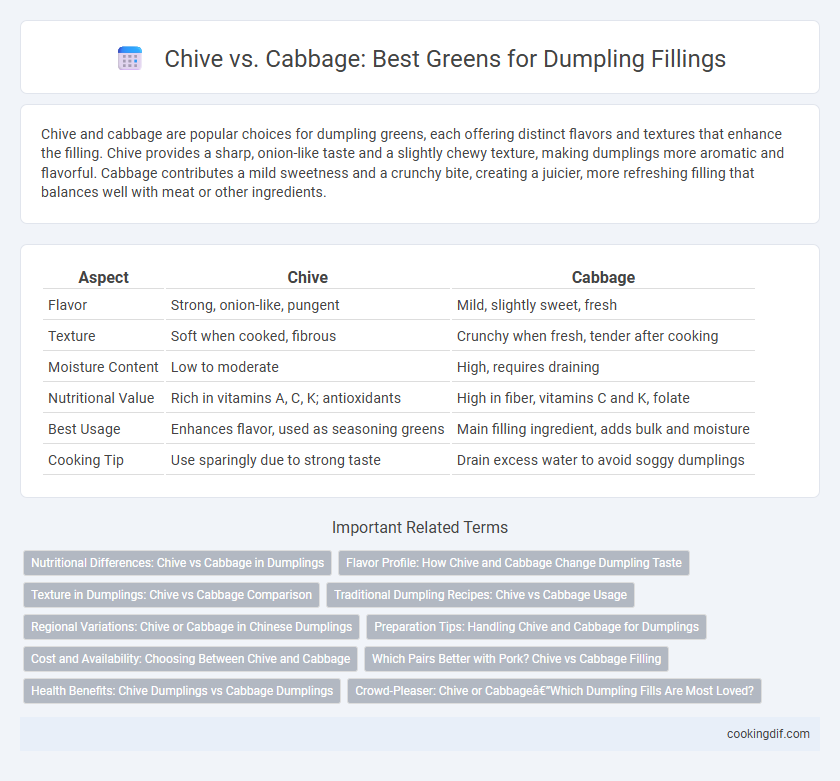Chive and cabbage are popular choices for dumpling greens, each offering distinct flavors and textures that enhance the filling. Chive provides a sharp, onion-like taste and a slightly chewy texture, making dumplings more aromatic and flavorful. Cabbage contributes a mild sweetness and a crunchy bite, creating a juicier, more refreshing filling that balances well with meat or other ingredients.
Table of Comparison
| Aspect | Chive | Cabbage |
|---|---|---|
| Flavor | Strong, onion-like, pungent | Mild, slightly sweet, fresh |
| Texture | Soft when cooked, fibrous | Crunchy when fresh, tender after cooking |
| Moisture Content | Low to moderate | High, requires draining |
| Nutritional Value | Rich in vitamins A, C, K; antioxidants | High in fiber, vitamins C and K, folate |
| Best Usage | Enhances flavor, used as seasoning greens | Main filling ingredient, adds bulk and moisture |
| Cooking Tip | Use sparingly due to strong taste | Drain excess water to avoid soggy dumplings |
Nutritional Differences: Chive vs Cabbage in Dumplings
Chives in dumplings offer higher levels of vitamins A and C, as well as antioxidants that support immune health, while cabbage provides greater amounts of dietary fiber and vitamin K, essential for digestion and blood clotting. Chives contain more folate and calcium, contributing to cell function and bone health, whereas cabbage is rich in glucosinolates, compounds linked to cancer prevention and detoxification. Choosing between chive and cabbage greens in dumplings can impact nutrient intake based on specific health benefits desired from these vitamin- and mineral-dense leafy vegetables.
Flavor Profile: How Chive and Cabbage Change Dumpling Taste
Chive imparts a sharp, slightly oniony flavor that enhances dumplings with a vibrant, aromatic kick, balancing rich fillings and adding freshness. Cabbage contributes a mild, sweet, and earthy taste, providing a tender texture that complements savory meat or vegetable fillings without overpowering other flavors. Choosing chive intensifies zestiness, while cabbage offers subtle sweetness, fundamentally altering the dumpling's overall flavor profile.
Texture in Dumplings: Chive vs Cabbage Comparison
Chive offers a tender yet slightly crisp texture that enhances the bite of dumplings without overpowering the filling. Cabbage provides a juicy crunch that adds moisture and a heartier mouthfeel, balancing the softness of the dough. Texture-wise, chive creates a delicate contrast while cabbage delivers a robust, satisfying chew in dumpling fillings.
Traditional Dumpling Recipes: Chive vs Cabbage Usage
Traditional dumpling recipes often highlight the distinct flavors of chive and cabbage as primary greens. Chive-based fillings provide a pungent, aromatic profile that complements pork or shrimp, while cabbage offers a mild, slightly sweet taste and a crunchy texture, balancing richer meats. The choice between chive and cabbage affects dumpling taste and texture, reflecting regional preferences and cultural variations in Asian cuisines.
Regional Variations: Chive or Cabbage in Chinese Dumplings
In Chinese dumplings, regional variations determine whether chive or cabbage is preferred as the primary green filling: northern China traditionally favors Napa cabbage for its mild flavor and juicy texture, while southern regions, especially around Guangdong, often use garlic chives for their pungent and aromatic qualities. These greens influence not only the taste but also the texture and moisture content of the dumplings, affecting cooking methods such as boiling, steaming, or pan-frying. The choice between chive and cabbage highlights the cultural diversity within Chinese cuisine, reflecting local agricultural practices and flavor profiles.
Preparation Tips: Handling Chive and Cabbage for Dumplings
When preparing dumpling greens, chives require gentle washing and thorough drying to prevent sogginess, maintaining their delicate texture and vibrant flavor. Cabbage should be finely shredded and salted to draw out excess moisture, then squeezed dry to avoid watery dumpling fillings. Proper handling of both ingredients ensures balanced texture and prevents the dumpling dough from becoming overly moist during cooking.
Cost and Availability: Choosing Between Chive and Cabbage
Chive dumpling greens typically cost more due to their limited seasonal availability and delicate harvesting process, while cabbage offers a budget-friendly, year-round option with widespread accessibility. Cabbage's robust texture and affordability make it a preferred choice for large-scale dumpling production, whereas chive's unique flavor profile justifies its higher price in gourmet or specialty dumplings. Considering cost efficiency and ingredient availability, cabbage remains the dominant choice for cost-conscious dumpling makers.
Which Pairs Better with Pork? Chive vs Cabbage Filling
Chive pairs better with pork in dumpling fillings due to its mild onion flavor that complements the rich, savory taste of pork without overpowering it. Cabbage, while offering a crunchy texture and subtle sweetness, can release excess moisture during cooking, potentially diluting the pork's flavor. For a balanced dumpling filling, chive enhances the overall taste profile and maintains the desired texture when combined with pork.
Health Benefits: Chive Dumplings vs Cabbage Dumplings
Chive dumplings offer high levels of vitamin K and antioxidants that support bone health and reduce inflammation, while cabbage dumplings are rich in vitamin C and fiber, promoting immune function and digestive health. Chives contain allicin compounds that help lower blood pressure, whereas cabbage provides glucosinolates linked to cancer prevention. Choosing between chive and cabbage dumplings depends on prioritizing cardiovascular benefits or enhanced detoxification and gut health.
Crowd-Pleaser: Chive or Cabbage—Which Dumpling Fills Are Most Loved?
Chive dumplings are celebrated for their bold, garlicky aroma and smooth texture that perfectly complement pork or shrimp fillings, making them a favorite in southern Chinese cuisine. Cabbage dumplings offer a mild, slightly sweet crunch that balances rich meats and adds moisture, commonly found in northern Chinese recipes. While chive dumplings appeal to those seeking a sharp, savory kick, cabbage dumplings attract fans who prefer a subtle, fresh vegetable bite, ensuring both remain crowd-pleasers depending on regional and personal taste preferences.
Chive vs cabbage for dumpling greens Infographic

 cookingdif.com
cookingdif.com